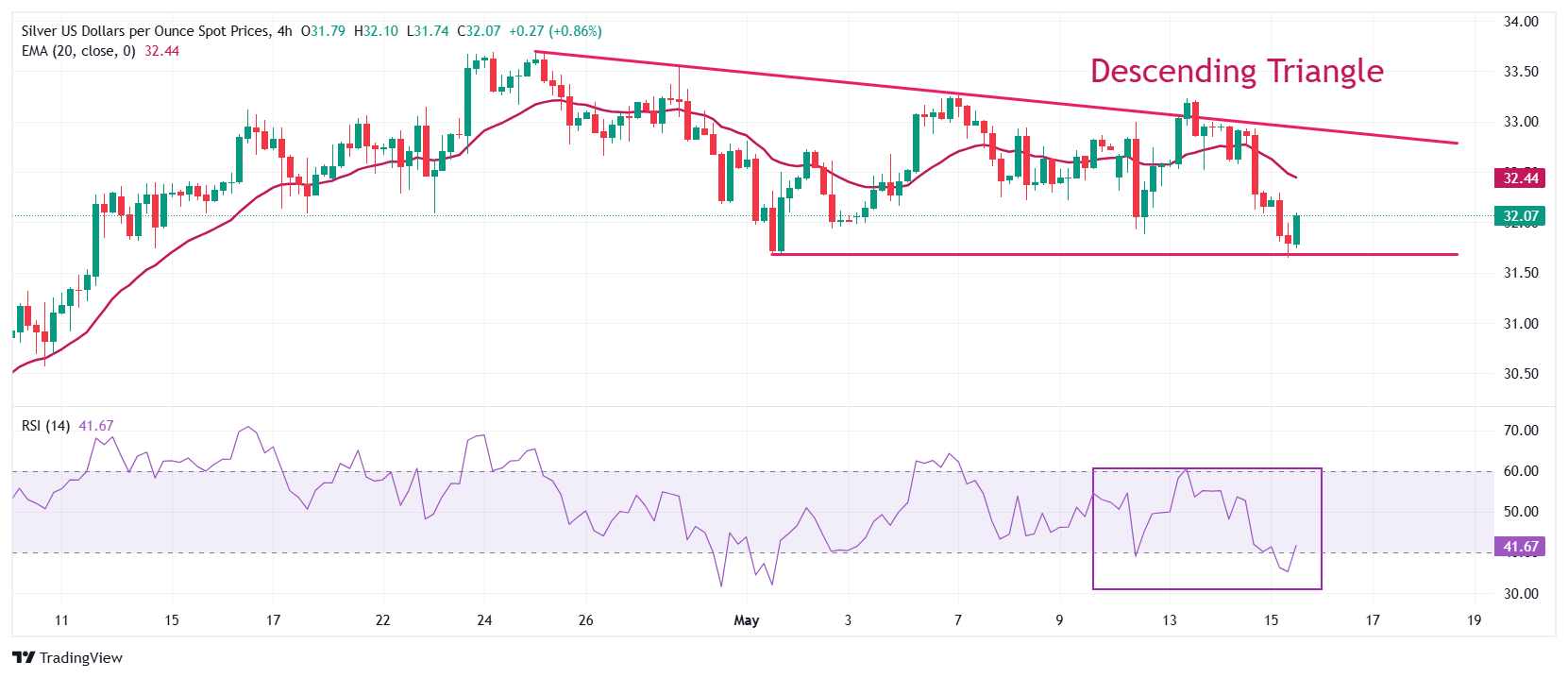- Silver price gains temporary ground below $32.00 ahead of Fed Powell’s speech.
- Signs of improving US-China trade relations have dampened the appeal of safe-haven assets.
- China has rolled back non-tariff measures on 45 US entities temporarily.
Silver price (XAG/USD) bounces back to near $32.00 during European trading hours on Thursday after sliding to near the monthly low around $31.65 earlier in the day. The outlook of the Silver price remains bearish as trade relations between the United States (US) and China have improved further.
During European trading hours, US Treasury Secretary Scott Bessent signaled more talks with China to avoid trade tensions. “We are going into a series of negotiations with China to prevent escalation again,” Bessent said.
Meanwhile, Beijing also appears to be making efforts to improve relations with the US. On Wednesday, the Chinese Commerce Ministry suspended non-tariff measures taken against 45 US entities in the wake of an agreement between Washington and Beijing for a 90-day pause in the trade war in which they lowered tariffs by 115%.
Waning US-China trade tensions have forced investors to reassess the global economic outlook. Theoretically, an improvement in the global economy reduces demand for safe-haven assets, such as Silver.
Meanwhile, investors await Federal Reserve (Fed) Chair Jerome Powell’s speech, which is scheduled in the North American session. Investors would look cues for any change in the Fed’s stance towards the monetary policy outlook after the temporary US-China trade truce and soft US Consumer Price Index (CPI) data for April.
The Silver price could face more pressure if Fed Powell guides that interest rates should remain where they are in the face of economic uncertainty due to new economic policies by US President Donald Trump. Fed’s higher for longer interest rates bode poorly for non-yielding assets, such as Silver.
Silver technical analysis
Silver price trades in a Descending Triangle formation on a four-hour timeframe. The chart pattern reflects indecisiveness among market participants. The near-term trend of the white metal is bearish as it trades below the 20-period Exponential Moving Average (EMA), which is around $32.70.
The 14-period Relative Strength Index (RSI) wobbles around 40.00. A fresh bearish momentum would trigger if the RSI falls below the 40.00 level.
Looking up, the March 28 high of $34.60 will act as key resistance for the metal. On the downside, the April 11 low of $30.90 will be the key support zone.
Silver four-hour chart

Silver FAQs
Silver is a precious metal highly traded among investors. It has been historically used as a store of value and a medium of exchange. Although less popular than Gold, traders may turn to Silver to diversify their investment portfolio, for its intrinsic value or as a potential hedge during high-inflation periods. Investors can buy physical Silver, in coins or in bars, or trade it through vehicles such as Exchange Traded Funds, which track its price on international markets.
Silver prices can move due to a wide range of factors. Geopolitical instability or fears of a deep recession can make Silver price escalate due to its safe-haven status, although to a lesser extent than Gold’s. As a yieldless asset, Silver tends to rise with lower interest rates. Its moves also depend on how the US Dollar (USD) behaves as the asset is priced in dollars (XAG/USD). A strong Dollar tends to keep the price of Silver at bay, whereas a weaker Dollar is likely to propel prices up. Other factors such as investment demand, mining supply – Silver is much more abundant than Gold – and recycling rates can also affect prices.
Silver is widely used in industry, particularly in sectors such as electronics or solar energy, as it has one of the highest electric conductivity of all metals – more than Copper and Gold. A surge in demand can increase prices, while a decline tends to lower them. Dynamics in the US, Chinese and Indian economies can also contribute to price swings: for the US and particularly China, their big industrial sectors use Silver in various processes; in India, consumers’ demand for the precious metal for jewellery also plays a key role in setting prices.
Silver prices tend to follow Gold’s moves. When Gold prices rise, Silver typically follows suit, as their status as safe-haven assets is similar. The Gold/Silver ratio, which shows the number of ounces of Silver needed to equal the value of one ounce of Gold, may help to determine the relative valuation between both metals. Some investors may consider a high ratio as an indicator that Silver is undervalued, or Gold is overvalued. On the contrary, a low ratio might suggest that Gold is undervalued relative to Silver.

